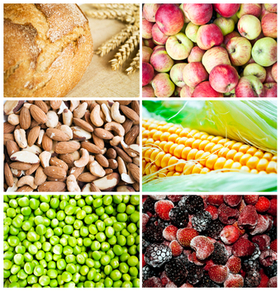
First think you have to understand is that food with a bar-code is always going to come with some misunderstanding about what it is. Because of creative marketing and FDA rules on what must be posted on labels, you can never guarantee what you are eating unless you eat real foods you make yourself from natural ingredients. Sometimes it is just not possibly to buy ONLY natural foods and we want to know how to best go about purchasing bar-code foods.
Low-fat: The amount of fat is represented by a percentage of weight of the product so the more ingredients without fat that you add, the lower percent of fat you can get. So the difference between the low-fat and the full-fat versions of foods is often that they added more unnatural ingredients to lower the fat percentage. Not that fat magically was removed from the product but it still tastes so good! Notice the calories from fat on the label and use that to calculate the real amount of fat in the product you are consuming.
Gluten-free: This label does not mean "healthy" it only means there is not the allergen gluten in it. It would be almost like labeling any food "nut-free" or "dairy-free" it only means that people do not have to worry about gluten in that product. This is great news for those with gluten intolerance that want to buy quick bar-code foods too. But these boxed gluten-free products often have just as many chemicals and additives as other boxed foods. While some companies are gluten-free and pride themselves in healthy ingredients, not all do. Make sure not to fall into this new marketing trap and look at the ingredients on the items you buy.
Sugar-free: The natural sugars in foods such as fructose and lactose must be chemically stripped from the ingredients and replaces with chemical-filled sweeteners in order to make something sugar free. Losing sugars is not worth the gaining of these potent chemicals.
All-natural: These porducts have to use SOMETHING to ensure you will buy it again, that is the point of marketing. Many products add cups of refined sugar to their "all-natural" product to make it delicious... and it is still all-natural. All-Natural Prego, for example, has almost a half cup of sugar.
Real Fruits and Veggies: This means they actually used real ingredients in your item. Great. What else did they use? Many of these products add a significant amount of sodium to their foods and drinks to get the same taste their consumers want while being able to label their product as healthy. Make sure to check the ingredients on the back. Even V8 has 20% of your daily recommended sodium intake in one serving.... what?
What you can do about all of this:
- The ingredients on the back of the box/bottle are organized in order of percent of the product, so the ingredient that is the largest percentage is first. Make sure your product doesn't have more sugar or salt than other main ingredients.
- If you cant pronounce something on the back and have never heard of it, I would suggest that it is not healthy and is full of chemicals.
- If there is an entire paragraph of ingredients, the food is so processed and mixed, it is not real any more, no matter what the labeling says. Look for a short ingredient list that has real foods in it.
- Be aware that ingredients that are washed out or only a very small portion (like chemicals used to break down the sugars) are not listed.
- Buy as much real food as you can. A bag of ripe oranges is always better than processed oranges.
I have some old posts on bar-code products with great ingredient profiles, if you want to check some tested foods out! Happy shopping!

 RSS Feed
RSS Feed